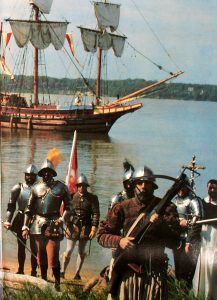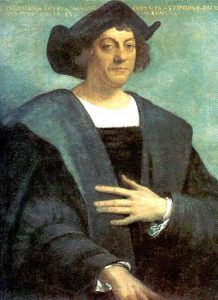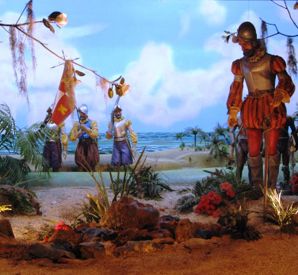who was the first spaniard to set foot in what is now the united states

De Soto Landing
Spanish Explorers:
Captain Juan Bautista de Anza Two (1736-1788)
Tristan de Luna y Arellano (1519-1571)
Helm Pedro Menendez de Aviles (1519-1574)
Lucas Vazquez de Ayllon (1475-1526)
Vasco Nunez de Balboa (1475?-1519)
Andres Dorantes de Carranza (1500?-1550s)
Sebastiao Melendez Rodriguez Cermeno (1560?-1602)
Christopher Columbus (1451-1506)

Francisco Vasquez de Coronado
Francisco Vasquez de Coronado (1510-1554)
Diego de Vargas (1643–1704)
Estevanico (1500?-1539)
Juan de Fuca (15??-1602)
Male parent Francisco Tomas Garces (1738-1781)
Father Eusebio Francisco Kino (1645-1711)
Juan Ponce de Leon (1460?-1521)
Panfilo de Narvaez (1478?-1528)
Fray Marcos de Niza (1495?-1558)
Juan de Onate (1550?-1626)
Captain Alonso Alvarez de Pineda (1494-1520)
Hernando de Soto (1500-1542)
Alvar Nunez Cabeza de Vaca (1490?-1558?)
"Gold is a treasure, and he who possesses information technology does all he wishes to in this world and succeeds in helping souls into paradise. "
— Christopher Columbus
Between 1513, when Juan Ponce de Leon first set foot in Florida, and 1821, when United mexican states gained her independence, also as the Spanish possessions in the present United States, Spain left an enduring influence — especially in the trans-Mississippi West, which the Usa began to acquire in 1803. Espana was the leading European power in the early on royal rivalry for control of Northward America and, for centuries, dominated the Southeastern and Southwestern parts of what was later the United States — specially usa of Florida, Texas, New Mexico, Arizona, and California.
Espana held Louisiana territory betwixt 1762 and 1803 and was, for the most office, content to foster the settlements founded there by France rather than to initiate new ones. She lost Florida temporarily in 1763 but regained it in 1783. Her possessions reached their maximum extent betwixt 1783 and 1803 when they ranged in a crescent from Florida to California.

Christopher Columbus
Except in California, Spain happened to colonize less fruitful regions than did England and France. Notwithstanding, she tenaciously clung to them long afterward she had lost her dominance in Europe, some years after the English defeated her fleet in 1588. Frustrated in their search for golden and precious metals, the Spaniards were usually forced to attempt to wrest a living from the arid soil of an inhospitable land by farming and ranching. Finding native labor much scarcer in the present United States than in her possessions to the south, Kingdom of spain was forced to spread her colonial empire dangerously thin. A small-scale number of soldiers, settlers, and friars controlled the native masses and, through their labors, obtained what wealth was to be had.
Kingdom of spain's motives for colonization were threefold: to locate mineral wealth, catechumen the Indians to Christianity, and counter French and English language efforts. The Spanish colonization organization was highly successful. First, an armed force subdued the natives and established forts, or presidios, for future protection. Then, zealous missionaries moved in to convert the Indians to the religion of Spain and teach them the arts of civilization. Finally, representatives of the King founded ceremonious settlements in conjunction with the presidios and missions. The Crown controlled the highly centralized process through a bureaucracy that burgeoned every bit the empire expanded. Simply, the story begins in the offset years of the 16th century, when Spain showtime realized that Columbus had discovered not island outposts of Cathay, just a New World!
In the two decades subsequently the showtime voyage of Columbus, Castilian navigators only began to realize the nature and extent of his remarkable detect. The presence of a continental landmass was surmised but not known. Columbus himself had sailed around Puerto Rico, charted most of the West Indies' shores, touched on the shores of South America, but, without realizing that it was a continent, and mapped the Primal American coast from Panama nearly to southern Yucatan.
On his showtime voyage, tardily in 1492, he had established the colony of Navidad on Hispaniola, but, finding it destroyed on his second voyage, he founded Isabella in January 1494. Isabella too failed within two years, and the colonists established Santo Domingo, the commencement permanent European settlement in the New Globe.

Juan Ponce de Leon
In 1508-1509, while Juan Ponce de Leon was occupying Puerto Rico and subduing its natives, Vicente Pinzón explored the southern Yucatan declension, and Sebastian de Ocampo circumnavigated the island of Cuba. In 1510, the Spaniards occupied Jamaica and, the following year, Cuba. In 1513, Vasco Nunez de Balboa, who dominated a struggling colony in nowadays Colombia, hacked a trail beyond the Isthmus of Panama and discovered the Pacific Ocean. In 1522, one of the five vessels of the Ferdinand Magellan expedition completed the first circumnavigation of the earth. The lure of chance and the thrill of discovery whetted the Spanish desire to explore.
Juan Ponce de Leon was the showtime Spaniard to touch on the shores of the present United States. Every bit Columbus had not remotely realized the extent of his momentous discovery, de Leon never dreamed that his "island" of Florida was a peninsular extension of the vast Due north American Continent. Later on coming to the New Globe with Columbus in 1493, he had led the occupation of Puerto Rico in 1508 and governed it from 1509 to 1512. In 1509, he started a colony at Caparra, later abandoned in favor of San Juan. He was one of the first of the adelantados — men who "advanced" the Castilian Empire by conquest, the subjugation of the Indians, and the establishment of quasi-war machine regime.
In 1513, the aging King Ferdinand awarded de Leona a patent to conquer and govern the Bimini Islands in the Bahamas, of which the Spaniards had heard but not yet seen. According to a persistent legend, de Leon would detect the marvelous leap whose waters would restore lost youth and vigor. Then many wonders had the Spaniards already encountered in the Western Hemisphere that only a cynic would have doubted the being of such a spring.
Past the time of de Leon's hapless endeavour to exercise his patent rights to the "island" of Florida in 1521, many geographers and navigators realized that Florida was probable the giant arm of a continent. 2 expeditions had indicated that this was true, i in 1519 past Captain Alonso Alvarez de Pineda and some other in 1521 by Francisco Gordillo.
The Pineda expedition was the inspiration of Francisco de Garay, Governor of Jamaica. He placed 4 vessels under the command of Pineda and ordered him to find a water passage around or through the landmass whose existence had been indicated by a series of Spanish explorations during the period 1515-18. Helm Alonso Alvarez de Pineda circled west and south around the coast from Florida to Vera Cruz. He named the land off his starboard bow "Amichel"; he called what was probably the Mississippi River "Rio del Espíritu Santo"; and he recommended a settlement at the mouth of the "Rio de las Palmas" — possibly the Rio Grande. Most chiefly, he gained substantial noesis of the unbroken coastline and revealed that to the due west of Spain'due south isle headquarters in the Caribbean lay a huge continental landmass.

Lucas Vazquez de Ayllon
Lucas Vazquez de Ayllon, a prominent magistrate in Hispaniola, in 1521 sent out Captain Francisco Gordillo to sheet northward through the Bahamas and strike the continent's shore, following part of de Leon'due south route and try to round the "isle" of Florida from the e. Upward the coast he tacked, extending de Leon's exploration at least 3° northward, and landing on the shores of present South Carolina. Ignoring orders, he loaded his send with innocent and friendly natives and put about for Hispaniola. He planned to sell his cargo into slavery to replace the large losses of natives during the first years of the Spanish conquest.
Lucas Vazquez de Ayllon reprimanded him and released the unfortunate captives but listened greedily to the study of the fair land to the n. Rushing to Spain, he obtained a patent to colonize the region. A reconnaissance expedition in 1525, led past Pedro de Quexos, extended De Ayllón's knowledge of the coast as far as present Virginia. The following year, later extensive grooming, Lucas Vazquez de Ayllon himself fix out with three vessels, more than 500 colonists, three padres, and aplenty supplies and livestock to plant a lasting settlement on the Atlantic shore. He failed. Attempting to settle get-go at an unknown site, perchance in present North Carolina, he shifted most 100 miles to the due south and founded a crude settlement named San Miguel de Guadalupe in South Carolina. He died of a fever before the year was out, and internal dissension rent the settlement into anarchy. Less than a 3rd of the colonists survived to return to Hispaniola.
The previous year a Portuguese navigator named Stephen Gomez, besides flight the flag of Espana, had completed the exploration of the Atlantic declension by sailing from Newfoundland due south to the Florida peninsula in search of the Northwest Passage. Clearly, the continental cake extended from Newfoundland to Tierra del Fuego. Intrepid Spanish explorers were forced off their ships and onto the land if they wished to make additional discoveries, as had Vasco Nunez de Balboa and Cortes earlier them.
Compiled and edited by Kathy Weiser/Legends of America, updated June 2021.
Too See:
Missions & Presidios of the United States
Early on America
Exploration of America
San Antonio Missions National Historic Park
woolnerexcerestint1993.blogspot.com
Source: https://www.legendsofamerica.com/spanish-explore/